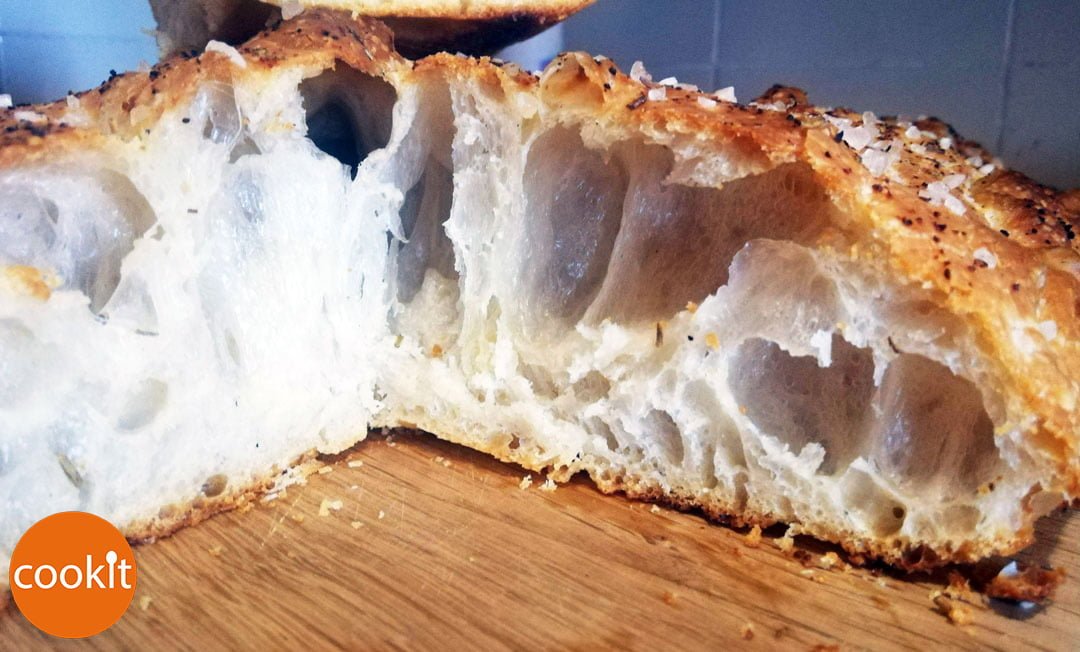Focaccia is a delicious Italian flatbread known for its crispy crust and airy interior. This recipe provides all the information you need to create this delectable bread at home! The recipe includes three variations and uses a special technique called “stretch and fold” to develop the gluten in the dough.
Here are some key things to remember from this recipe:
- The dough needs to rest in the refrigerator for 24 to 72 hours, allowing for a slow fermentation process that enhances flavour and texture.
- Autolysis, a fancy term you might encounter in the recipe, refers to the process where the dough rests and the flour hydrates, which also contributes to a superior final product.
So, if you’re looking to bake delicious and impressive bread, look no further than this Focaccia recipe!

Ingredients with fresh yeast
| 1 kg | Flour (strong or Manitoba) |
| 700 grs | Water |
| 20 grs | Olive oil |
| 20 grs | Salt |
| 10 grs | Fresh yeast |
Ingredients with poolish
| 500 grs | Flour (strong or Manitoba) |
| 200 grs | Water |
| 20 grs | Olive oil |
| 20 grs | Salt |
| 1 kg | Poolish |
Ingredients with sourdough
| 850 grs | Flour (strong or Manitoba) |
| 550 grs | Water |
| 20 grs | Olive oil |
| 20 grs | Salt |
| 300 grs | Sourdough |
Instructions

Put the oil, water, and yeast (yeast, poolish or sourdough) in a container.

Mix.

Add the flour, mix, and rest for 30 minutes in the refrigerator. During this time, the autolysis process will take place. This will help develop our dough. Once the 30 minutes have passed, we add the salt to our dough and integrate it.

First fold – Step 1 – Put your hand in the water and then proceed to take the dough from the top side.

First fold – Step 2 – Stretch the dough without breaking it and bring it to the bottom side.

First fold – Step 3 – We take the bottom side and bring it to the top side.

First fold – Step 4 – We take the left side and bring it to the right side.

First fold – Step 5 – We take the right side and take it to the left side.

Rest in the refrigerator for 30 minutes.

Second fold – Repeat the steps of the first fold and rest for 30 minutes in the refrigerator.

Third fold – Repeat the steps of the first fold and rest for 30 minutes in the refrigerator.

Fourth fold – Repeat the steps of the first fold and rest for 30 minutes in the refrigerator. With each fold we see that the dough is taking strength and tension.

Cover and rest for 24 to 72 hours in the refrigerator.

Place olive oil generously on the entire surface of the baking tray. Place the dough directly on the baking tray without degassing. Stretch the dough carefully. If it is elastic, let it rest for 20 minutes and try again. Leave the dough to rise for 1 hour.

With the tips of our fingers, we make holes in the whole dough (without perforating it).

Emulsify two tablespoons of olive oil and two tablespoons of water. Paint our dough with this emulsion. We can put rosemary, salt flakes and black pepper.

At this point, we can add our favourite ingredients. For example, black olives.

Cook in an oven at 482° F (250° C) for 20 minutes. After removing from the oven, the focaccia must be placed on a wire rack and let cool.

Enjoy.

Enjoy.

Enjoy.
Notes
- Autolysis is the process by which cells self-destruct by the action of their enzymes.
- Two of the most important enzymes of the flour in the dough are the amylase, which provides elasticity, and the protease, which provides structure.
- The focaccia can be portioned and frozen.
- The stretch and fold technique is recommended in doughs of high hydration or in doughs that ferments for more than two hours.
- We can include fresh yeast in recipes with sourdough or poolish.

